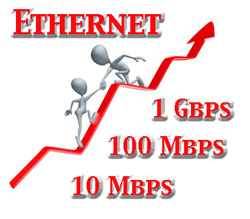By: John Shepler
Modern applications require increasingly high bandwidth. A 10 Mbps connection, considered entry-level, is often insufficient for businesses. Many need at least 100 Mbps WAN bandwidth to support real-time applications like VoIP and video conferencing, as well as latency-sensitive cloud connections. This ensures optimal performance even during peak usage. Larger businesses and those with technology-heavy needs might even require Gigabit connections, which are now readily available and more affordable than in the past.
Carrier Ethernet is a significant technological advancement in MAN (Metropolitan Area Network) and WAN (Wide Area Network) bandwidth over the past decade. It’s a departure from legacy SONET/SDH, a circuit-switched technology designed for telephone networks, and embraces the prevalence of packet-switched traffic on global networks. Carrier Ethernet extends the common language of Ethernet from local networks to the wider network infrastructure.
Suitable for both copper and fiber lines, Carrier Ethernet offers lower bandwidth options through EoC (Ethernet over Copper), using existing cabling for T1 and phone lines. EoC typically offers speeds from 1-3 Mbps up to 10-20 Mbps, with exceptions in some cases reaching 50-100 Mbps near the telecommunications company’s equipment. However, copper-based Ethernet’s bandwidth capacity diminishes over distance.
Ethernet over Fiber is generally the preferred solution for high-performance applications, with speeds starting at 10 Mbps and reaching up to 10 Gbps. Common service levels include 10 Mbps, 100 Mbps, and 1 Gbps, mirroring typical LAN speeds.
Several factors contribute to Carrier Ethernet’s affordability and flexibility compared to traditional SONET services. Competitive carriers have built their own fiber networks, independent of traditional telephone systems, giving them control over infrastructure and pricing. This has resulted in a competitive market with significant drops in lease prices per Mbps.
Carrier Ethernet’s scalable design offers additional cost savings. Traditional TDM-based bandwidth requires specific equipment for each service level (e.g., T1, DS3, OC3). Upgrading to a faster service meant installing new equipment, leading to increased costs and installation times.
Carrier Ethernet, however, functions seamlessly regardless of the traffic volume; what matters is the installed port’s speed. This maximum capacity determines the bandwidth limit. A Fast Ethernet port supports up to 100 Mbps, while a Gigabit Ethernet port goes up to 1000 Mbps.
Operating below the maximum capacity is entirely possible. While other services offer fractional line speeds, the cost savings with Ethernet are significantly more substantial.
The ease of scalability is a key advantage of Carrier Ethernet. Many carriers allow bandwidth upgrades with a simple phone call, activating the added capacity within hours or days, unlike the weeks or months required for older technologies.
This is where Gigabit Ethernet proves beneficial even if the full capacity isn’t immediately needed. By installing a Gigabit Ethernet port, a common feature in carrier-provided routers, users can start with lower bandwidth (e.g., 100 Mbps or 200 Mbps) and easily upgrade (e.g., 500 Mbps, 750 Mbps) as their needs grow, ultimately utilizing the full Gigabit capacity.
For those who need even more bandwidth, 10 GigE or even 100 GigE ports are options. As demand continues to rise, carriers are expected to upgrade their networks to Terabit speeds and beyond, making these speeds accessible to businesses and organizations with high-demand applications.
If your organization struggles with bandwidth constraints, exploring the availability and cost of fractional and full Gigabit Ethernet services, or even higher speeds, could be worthwhile.


